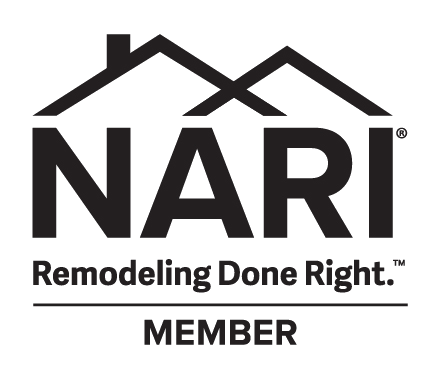Designing a Kosher Kitchen
Having grown up in a traditional Jewish household that followed strict kosher guidelines, there is no one more capable to design a kosher kitchen than Harrell Design + Build designer, Debra Winston. So when Harrell was approached by a couple to update their circa-1960s kitchen while incorporating solutions that would allow them to adhere to their kosher meal preparation, Debra was exceptionally qualified for the task.
The 50-year-old kitchen was dark and dated. Counter space was limited as was storage. Though the kitchen had an eat-in area, it wasn’t used as the couple ate meals in their Dining Room. The husband is kosher and his wife, a gourmet cook with Italian roots, converted to Judaism and also observes kosher practices. They enjoy entertaining and preparing large meals for friends and family, especially during Passover (also known as “Pesach”).

There are three categories of kosher foods: meat, dairy, and pareve, which include fruits, vegetables, grains, eggs, and other foods. To simplify the kosher concept, there must be dedicated pots, pans, knives, bowls, dishware, and utensils for preparing, cooking, serving, and eating meat and dairy dishes. This means there are two sets of everything in addition to special dishes and serving platters for Passover. With extensive sets of duplicate cookware to function properly and follow kosher requirements, the kitchen needed considerable storage. Debra’s clients also wanted high-performance appliances as well as more counter space.
After speaking in-depth with her clients, visiting their home, and armed with her personal knowledge of the kosher standards, Debra embarked on transforming their kitchen. The end result may not look any different from a classic kitchen redesign but the changes Debra incorporated made a huge difference in the couple’s ability to easily and enjoyably prepare kosher meals for themselves and guests.
“I enjoy taking a poorly designed space, and reconfiguring it with an improved layout, enhanced lighting, increased accessibility, and heightened functionality,” states Debra of one of the many things she enjoys about her job as a Harrell’s designer.
Interested in a kitchen remodel? Harrell Design + Build can help!
Some of the key elements of this
kosher kitchen include:
Storage, Storage, Storage
In this kosher kitchen, storage – and lots of it – was a crucial component of the redesign.
Separate Storage for Meat & Dairy
Base cabinet drawers on either side of the range were designed for pots, pans, and other cooking utensils. One side was dedicated for tools and cookware for meat, the other for dairy. There were also independent drawers for each full set of silverware and utensils. The upper cabinets had enough space to separate meat and dairy plates as well as serving dishes.
Double Height Pullout Pantry
A tall narrow pantry next to the refrigerator houses spices, condiments, and a variety of ingredients. The two Kessebohmer hardware inserts hold 330 pounds each, and are open from both sides making for easy visibility and accessibility.
Secondary Cabinets for Pesach Storage
Upon gutting the kitchen a false ceiling was discovered, which enabled the ceiling height to be raised from 95 inches to 103 inches. This allowed for secondary upper cabinets ideal for storing Passover china that is only used once a year. A cabinet above the wall oven houses vertical baking tray dividers measured to fit the owner’s baking sheets and adjustable shelves offer additional flexible storage.

Drawers
One of the drawers is composed of a two-tiered wood cutlery drawer with dividers, creating additional space for separate meat and dairy flatware and utensils. Another drawer has a knife block insert on the left side, and dividers to organize utensils on the right.
Blind Cabinets
Although there was not enough space in the kitchen for Magic Corners or swing-out half round shelves, we were able to make the blind cabinets useful. These cabinets are installed with lighting that automatically turns on, allowing easily visibility to all areas. These are used to hold trash bins, tall vases, and other items not needed on a regular basis.
Display Cabinets
Glass cabinets and niches offered multiple ways for the homeowners to display special dishes, tchotchkes, and other objets d’art.
Double Basin Sink
In a kosher kitchen, a double basin sink is required so that meat and dairy items can be washed separately. The divide in the new sink is 6” in height, allowing pots with long handles to extend over the divider. They can soak without encroaching on or dumping water into the other side. A Blanco Silgranite sink was chosen because of its durability to resist scratches, stains, and heat. This was accented by a Brizo single-handle pull-out faucet and a filtered instant hot water tap.
High-End Appliances
A love of cooking and Italian heritage coupled with kosher standards necessitated desire for modern, high-performance appliances. A Sub-Zero refrigerator with wood paneling to match the cabinetry enabled them to have enough space to isolate meat and dairy. A gas 4-burner Wolf Range Top provides efficient and consistent cooking while a warming drawer takes the chill off plates and keeps prepared foods at the perfect temperature until the meal is served. In lieu of a microwave, the homeowners opted for a Miele Speed wall oven. Its compact size allows it to heat quickly, and the use of steam ensures healthy, fast food preparation. A traditional Miele convection oven is right below, allowing plenty of options when preparing meals for large gatherings.

Countertops, Flooring, Lighting, Flow
Cambria Brittanicca countertops mimic a classic white veined marble without the worry of stains, etching, or upkeep. The old engineered wood floors were replaced with authentic oak hardwood. LED lighting was used in a variety of manners to provide ambient, task, and accent illumination, all of which brightened the previously gloomy space. And, the once narrow entry into the Dining Room was widened to 45 inches, allowing a better flow between the two rooms.
Thanks to Debra Winston, this gorgeous kosher kitchen has everything the homeowners desired. The new floor plan doubled the usable space, storage abounds, and the 1965 GE stove has been replaced by top-of-the-line Sub-Zero, Wolf and Miele appliances. With its copious storage, large double sink, and improved lighting this kitchen would also work well for those people with unique dietary requirements or food allergies who must segregate food and/or cooking tools.
“I have dreamed of working with Harrell Design + Build for more than 20 years, such is their reputation for smart, impeccably designed and crafted spaces. The danger of such dreams is creating unreasonable expectations, but Harrell exceeded all of them in the rebuild of my kitchen. There are few people who can boast of having fun during a kitchen remodel; I am one of them. Unbelievable attention to detail, quick problem solving, spectacular communication (including on the job site, where I learned so much that has made me a better homeowner)… we simply could not have done this with anyone else and emerged with our day jobs and marriage intact!”
Debra has been with Harrell Design + Build Design + Build for four years. She has a Bachelor’s degree in Fine Arts, is a painter and quilt artist, and spent 13 years as a fashion designer for Ralph Lauren in New York City before moving to California. She studied Interior Design at Cañada College, where she specialized in Kitchen and Bath Design and worked as an Interior designer prior to joining the Harrell Team in April 2014. She has received numerous awards for her designs. Debra specializes in Kitchen and Bath redesign, is a Universal Design Certified Professional (UDCP), and also works on whole-house remodels and room additions.










